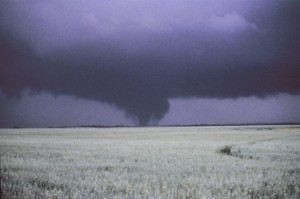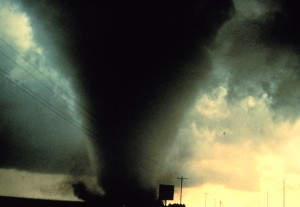RESEARCH LITERATURE SEARCH
Tornado researchers generally acknowledge phenomena similar to tornados that are not associated with supercell storms; such as squall line tornados, water spouts, and dust devils; however, research attention has been focused on supercells because nearly all of the most intense tornado events, and the most predictable places to find tornados, are in association with supercell thunderstorms (Markowski and Richardson 2009). Research then proceeds based on the unique characteristics of supercells, real or hypothesized, neglecting the fact that these unique characteristics provide little, if any, insight towards explaining acknowledged related phenomena. The widely accepted current theory of tornadogenesis involves tilting and stretching of horizontal vorticity that has been induced by opposing wind shear, then brought to the ground, most likely by a rear-flank downdraft (RFD) (Markowski et al. 2002; Dowell and Bluestein 2002; Davies-Jones 2006; Grzych et al. 2007; Markowski and Richardson 2009). No attempt is made to explain how this theory relates to documented and consistently reported tornado event observations:
- Calm, muggy, ambient precursor conditions at the ground (the “calm before the
storm”). - The pendant wall cloud formation that frequently precedes tornado development.
- The tornado emerging out of the wall cloud, if one has developed.
- The fact that tornados touch down perpendicular to the ground.
- The funnel cloud shape – generally expanding with increasing altitude.
- The cloud surrounding the base of mature tornados at the ground.
- The “freight train” sound that is consistently reported by survivors.
Numerous tornadogenesis theories have been proposed over the years including lightning, planetary rotation induced vertical vorticity, entropic effects, and wind shear effects to name just a few. Observations during airborne radar data collection during the Cooperative Oklahoma Profiler Studies (COPS-91) found inconsistent evidence of lightning effects (Dowell et al. 1997). Armstrong (2005) investigates air-to-air lightning and all but dismisses it by concluding that the extreme electrification necessary to induce a tornadic updraft is supported by the rarity of tornado events. Davies-Jones (2006) reviews the then-current state of supercell tornadogenesis research, dismissing repeated lightning strikes as a causation factor due to lack of supporting observational evidence. Davies-Jones (2006) does not mention the entropic balance theory proposed by Sasaki in 1999. Entropy, in the form of condensation, does play a key role in tornadogenesis; however, not in the manner advocated by Sasaki (2010) which extended the examination of RFD-related causation. Sasaki (2010) notes the inconsistency between tilting vorticity and the fact that tornados touch down perpendicular to the ground.
 Markowski and Richardson (2009) also summarize the current understanding of tornadogenesis. They also cite the widely accepted concept of tilting and stretching of horizontal vorticity, treating it as established science. Markowski et al. (2008) find arching of vortex lines by examining 1995 Verification of the Origins of Rotation in Tornados Experiment (VORTEX1) airborne radar data from three non-tornadic supercells and three tornadic supercells. They illustrate arching behavior in each example of both storm types, and then fail to make a distinction, or even suggest a theory, as to why tornados formed in three examples and not in the other three. Updrafts and downdrafts are presented as shaping and directing pre-existing vortices, formed by opposing wind shear that causes infinite numbers of rotating air cylinders, positioning them to behave tornadically. How wind shear induced rotation is maintained in the updraft and downdraft environment is not addressed. Nor is the means by which a sheet of rotating air cylinders is resolved into a discrete tornado funnel cloud.
Markowski and Richardson (2009) also summarize the current understanding of tornadogenesis. They also cite the widely accepted concept of tilting and stretching of horizontal vorticity, treating it as established science. Markowski et al. (2008) find arching of vortex lines by examining 1995 Verification of the Origins of Rotation in Tornados Experiment (VORTEX1) airborne radar data from three non-tornadic supercells and three tornadic supercells. They illustrate arching behavior in each example of both storm types, and then fail to make a distinction, or even suggest a theory, as to why tornados formed in three examples and not in the other three. Updrafts and downdrafts are presented as shaping and directing pre-existing vortices, formed by opposing wind shear that causes infinite numbers of rotating air cylinders, positioning them to behave tornadically. How wind shear induced rotation is maintained in the updraft and downdraft environment is not addressed. Nor is the means by which a sheet of rotating air cylinders is resolved into a discrete tornado funnel cloud.
Markowski et al. (2008) illustrates vortex rings superimposed on a supercell photograph that shows a classic pre-tornadic storm formation. Actual clouds like the ones shown in the photograph never exhibit the illustrated vorticity. The air below the anvil preceding tornado formation is generally calm and the cloud ceiling is essentially static, floating along at the same general speed as the overall cold front. Any rotation prior to tornadogenesis beneath the anvil is large scale about a vertical axis associated with the development of a mesocyclone, not in vortex rings as illustrated. The lack of significant air movement below the anvil of a pre-tornadic supercell is fundamentally inconsistent with the concept of opposing wind shear vortex lines along the ground arching due to opposing updrafts and downdrafts as a means of tornadogenesis.
Davies-Jones (2006) treats the idea of tilting horizontal vorticity as settled science based on numerical modeling that discredited pre-existing planetary vertical vorticity as a factor. The mystery of tornadogenesis that remained for Davies-Jones (2006) was the process by which near-ground rotation (a tornado by definition) develops from tilting and stretching horizontal vorticity. Markowski et al. (2003) numerically modeled an optimized RFD temperature to maximize the lift characteristics of warmth, contributing to the updraft; while still being cold enough to get to the ground. The forcing mechanism that makes the RFD flow towards the ground was treated as a given initial condition, with no assessment of the driving force that allegedly causes it.
Wurman et al. (2012) reviews research results of the second Verification of the Origins of Rotation in Tornados Experiment (VORTEX2) which connects the timing of the formation of a descending reflectivity core (DRC) with intensified low level rotation. Markowski and Richardson (2009) report that the probability of a supercell becoming tornadic increases with elevated environmental boundary layer relative humidity. This, along with the DRC revealed by VORTEX2, suggests that entropy is likely to be a significant factor. However, the fundamental initiating requirement of tornadogenesis is a factor that is conspicuously absent from the research literature: pressurization.
The driving force that initiates tornadogenesis is the pressurization of trapped warm air on a large scale. Mesocyclones are rising streams of warm air, escaping the pressurized environment. Expansion of the mesocyclone at higher altitudes generates negative pressure aloft which combines with the positive pressure below to induce high velocity air flow. As the warm air rises it sheds moisture, and it is the condensation surrounding the rising stream of warm air that is brought to the ground by gravity to form a tornado. A tornado is not a rotating cylinder of air; it is a rising stream of escaping pressurized air within a falling conduit of condensation, both exhibiting natural opposing cyclonic rotation. Tornados and related phenomena are fundamentally driven by pressurization.
Section 2 outlines the pressurization and condensation tornadogenesis theory conceptually, identifying the natural processes that initiate, sustain, and dissipate tornados. Section 3 provides case study evidence supporting the theory by following National Climatic Data Center (NCDC) radar data and documentation of two significant events: 22 May 2011 Joplin, Missouri; and 20 May 2013 Moore, Oklahoma. Section 4 provides a summary and discussion.
REFERENCES
Dowell, D.C., and Bluestein, H.B., 2002, The 8 June 1995 McLean, Texas, Storm. Part I: Observations of Cyclic Tornadogenesis, Mon. Weather Rev. 130, 2626-2648.
—-, and —-, 2002, The 8 June 1995 McLean, Texas, Storm. Part II: Cyclic Tornado Formation, Maintenance, and Dissipation, Mon. Weather Rev. 130, 2649-2670.
—-, —-, Jorgensen, D.P., 1997, Airborne Doppler Radar Analysis of Supercells during COPS-91, Mon. Weather Rev. 125, 365-383.
Davies-Jones, R., 2004, Growth of Circulation around Supercell Updrafts, J. Atmos. Sci., 61, 2863-2876.
—-, 2006, Tornadogenesis in Supercell Storms – What We Know and What We Don’t Know, Symposium on the Challenges of Severe Convective Storms, Amer. Meteor. Soc.
—-, and Trapp, R.J., 1997, Tornadogenesis with and without a Dynamic Pipe Effect, J. Atmos. Sci., 54, 113-133.
Gilmore, M.S., Straka, J.M., Rasmussen, E.N., 2004, Precipitation and Evolution Sensitivity in Simulated Deep Convective Storms: Comparisons between Liquid-Only and Simple Ice and Liquid Phase Microphysics, Mon. Weather Rev. 132, 1897-1916.
Grzych, M.L., Lee, B.D., Finley, C.A., Thermodynamic Analysis of Supercell Rear-Flank Downdrafts from Project ANSWERS, Mon. Weather Rev. 135, 240-246.
Lee, B.D., Jewett, B.F., Wilhelmson, R.B., 2006, The 19 April 1996 Illinois Outbreak. Part I: Cell Evolution and Supercell Isolation, Weather and Forecasting, 21, 433-448.
—-, —-, —-, 2006, The 19 April 1996 Illinois Outbreak. Part II: Cell Mergers and Associated Tornado Incidence, Weather and Forecasting, 21, 449-464.
Markowsi, P.M., and Richardson, Y.P., 2009, Tornadogenesis: Our current understanding, forecasting considerations, and questions to guide future research, Atmospheric Research, Elsevier, 93, 3-10.
—-, Rasmussen, E., Straka, J., Davies-Jones, R., Richardson, Y., Trapp, R.J., 2008, Vortex Lines within Low-Level Mesocyclones Obtained from Psuedo-Dual-Doppler Radar Observations, Mon. Weather Rev. 136, 3513-3535.
—-, Straka, J.M., Rasmussen, E.N., 2003, Tornadogenesis Resulting from the Transport of Circulation by a Downdraft: Idealized Numerical Simulations, J. Atmos. Sci., 60, 795-823.
—-, —-, —-, 2002, Direct Surface Thermodynamic Observations within the Rear-Flank Downdrafts of Nontornadic and Tornadic Supercells, Mon. Weather Rev. 130, 1692-1721.
—-, Rasmussen, E.N., Straka, J.M., Dowell, D.C., 1998, Observations of Low-Level Baroclinity Generated by Anvil Shadows, Mon. Weather Rev. 126, 2942-2958.
Nowotarski, C.J., Markowsi, P.M., Richardson, Y.P., 2011, The Characteristics of Numerically Simulated Supercell Storms Situated over Statically Stable Boundary Layers, Mon. Weather Rev. 139, 3139-3162.
Sasaki, Y.K., 2010, Entropic Balance Theory and Tornadogenesis, Nova Science Publishers, Inc., ISBN: 978-1-61761-683-9.
Wakimoto, R.M. and Liu, C., 1998, The Garden City, Kansas, Storm during VORTEX 95. Part II: The Wall Cloud and Tornado, Mon. Weather Rev. 126, 393-408.
Wurman, J., Dowell, D., Richardson, Y., Markowski, P., Rasmussen, E., Burgess, D., Wicker, L., Bluestein, H.B., 2012, The Second Verification of the Origins of Rotation in Tornados Experiment, Bull. Amer. Meteor. Soc., August, 1147-1170.
